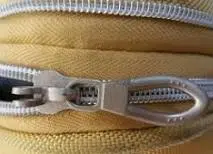Before delving fully into knowing the meaning of the term zipper, it is essential to discover its etymological origin. In this case, we can state that it derives from French, specifically from the word "crémailleré" which emanates from the Latin "cramaculus" and this, in turn, from the Greek "kremaster", which meant "that hangs".
The term is used to refer to the closure used on clothing, bags and other products.
 The zipper consists of two strips that, on their edges, have teeth that lock (to close) and unlock (to open) each other. To operate the mechanism, the person must move a slider or handle up or down or to one side or the other.
The zipper consists of two strips that, on their edges, have teeth that lock (to close) and unlock (to open) each other. To operate the mechanism, the person must move a slider or handle up or down or to one side or the other.
Also called a zipper or simply a closure , the zipper allows you to join or separate two pieces or two parts of the same piece . Jackets, pants , wallets, suitcases and bags are some of the items that usually have zippers.
Thus, we can state that every zipper is made up of a textile tape or band, teeth, an upper stop, the chain, the puller, the separator tube, the reinforcement, the separator box, the lower stop, the lower part and the cursor or carriage.
Within the field of fashion, it is important to know that there are different types of zippers, among which the following stand out:
-Metal zipper. This has an attractive finish, is made of brass material and is widely used because it stands out for its resistance. In the same way, we cannot ignore that it can be presented in a wide variety of colors.
-Multipurpose, which has the particularity of being made of polyester and is identified because the teeth are in the shape of a spiral. It has different uses and can be found for sale with dimensions ranging from 10 centimeters to one meter.
-Injected zippers are those that are usually thick and also offer great resistance. Of course, his teeth are plastic. They can be found mainly in sports clothing as well as in backpacks and bags and even in footwear such as ankle boots.
In the field of mechanics , a rack is a bar that has teeth on one edge, enabling gearing with a pinion to convert a rectilinear movement into a circular one and vice versa. In this type of mechanism, the pinion meshes with the rack in such a way that, when the pinion rotates, the rack moves linearly.
The steering of cars , for example, has a rack. The steering wheel is linked to a steering column, in turn associated with a rack and pinion, which allow the movement of an articulated bar that is linked to the wheel support.
On a rack railway , the train advances from its coupling with the track through a third rail , which is precisely a rack. The sprocket that is mounted on the locomotive transmits the force to this rail.
These railways are usually found in mountain areas since the rack makes it easier to climb the slopes. The system is also used on roller coasters .
